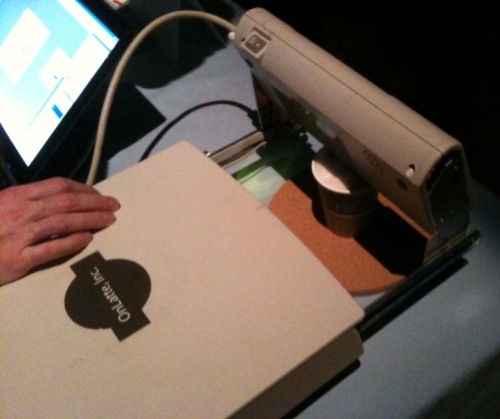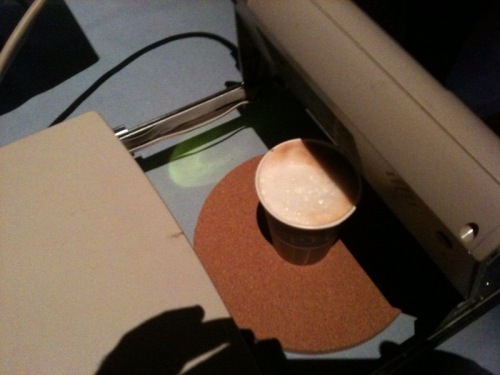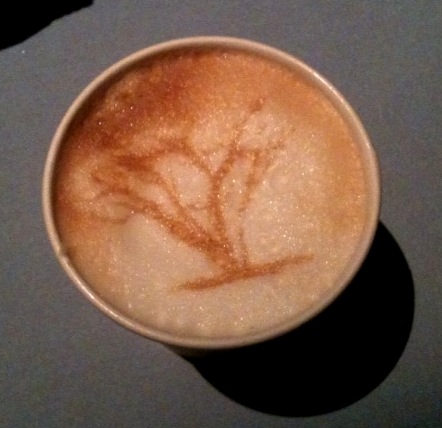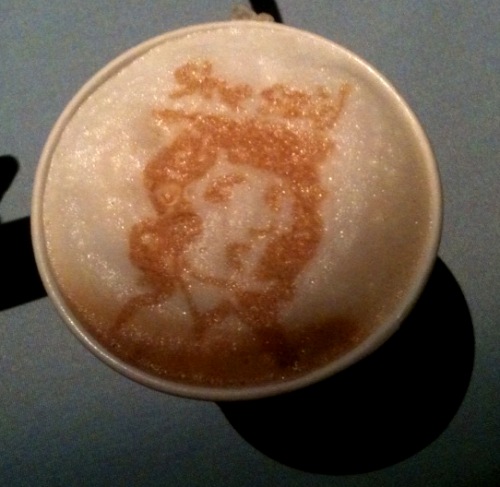Previous: Now let us praise The New Criterion (149)
October to November
Post #1435 • December 22, 2009, 12:01 PM • 37 Comments
New at The Moon Fell On Me.
In other comics news, Inbound #4 is selling like hotcakes, and the talented Gareth Hinds gave yours truly an especially positive mention in his review of it.
Also, a couple of weekends ago at the ATNE Spark Gala, Oleksiy Pikalo demonstrated his invention, a digital printer that outputs edible ink onto latte foam. He invited us to try some images, so I pulled a couple from The Moon Fell On Me.



Latte image from Crabapple

Latte image from Model
2.
December 22, 2009, 5:04 PM
Rust gets a bad rap, as far as patinas go. It's ironic, really.
3.
December 22, 2009, 6:10 PM
Wow, that was subtle.
4.
December 22, 2009, 6:46 PM
What was subtle? Did I miss something?
Anyway. You know, every time the weather is inclement I remember John Daido Loori schooling you in Italian, and in a way he's schooling me, too. It reminds me by association of The Moon Fell on Me, which is a very Zen kind of comic strip.
5.
December 22, 2009, 6:56 PM
A different rust-like effect:
Seto 1
Seto 2
Seto (detail a)
Seto (detail b)
6.
December 22, 2009, 7:04 PM
Did I miss something?
Stare at #2 for a while.
Something I've noticed about Zen is that the example of these realized people has an effect on the world without their going out of their way to do anything. It's amazing.
Jack, am I totally off-base here, or does that vase look vaguely Greek?
7.
December 22, 2009, 7:12 PM
I suppose it might, but it's a Japanese flower vase. You're probably thinking an elongated amphora, most likely because of the little handles. It has a sleek, earthy elegance, a kind of glamour, that's very appealing to me because I think it just happened--I doubt the potter was thinking in those terms at all.
8.
December 22, 2009, 7:13 PM
Oh, ha ha, I get it. #2 is funny, and sometimes it's hot and runny.
9.
December 22, 2009, 8:35 PM
Check this out:
Vase 1
Vase 2
Vase 3
Vase (detail a)
Vase (detail b)
Richter? Richter can kiss my butt.
10.
December 22, 2009, 9:35 PM
Very beautiful Jack. Here's a beautiful contemporary pot. I saw it in Joan Merviss's booth at SOFA N.Y.last year. It was mounted vertically on a wall as a flower vase, about 20 + " with a wonderful surface. I don't recall the maker's name just now.
11.
December 22, 2009, 9:45 PM
Very nice, David. Like tree bark. I'm sure it was even nicer in person.
Question: Why is aesthetic satisfaction so easy to find in Japanese ceramics, and so ridiculously difficult to come by in "serious" contemporary art?
12.
December 22, 2009, 10:11 PM
Some prints from Yoshitoshi's Moon series (Meiji era):
(Click on each image once it comes up to get a better image)
Priest in Thought
Moon of the Pleasure Quarter
Moon and Ghost
13.
December 22, 2009, 10:49 PM
The flower vase is by:
Wada Morihiro (1944 - 2008)
Sculptural horizontal vessel decorated with abstract designs
2005
Stoneware and colored slip glazes
6 1/4 x 28 x 6 1/4“
As to your question Jack, I'm sure we/you all have been over this many times. The aesthetic is ancient and integral to the culture, although I'm fascinated by contemporary studio craft artists in japan who've tried to reinvigorate the traditional crafts by getting sculptural and experimental. The ceramic and bamboo artists especially have pushed the boundaries in an effort to survive and keep their crafts alive. According to a dealer at the Tai Gallery I spoke to, the bamboo artists were dying off or starving when a few tried to develop sculptural forms that broke away from being useful objects. And evidently they found a market. The description "sculptural vessel with abstract design" says it all. It works on several levels - as sculpture, vessel and abstraction. A nice little aesthetic package that a cultured person can appreciate and enjoy. Abstraction is a key component too, and also ancient.
14.
December 23, 2009, 8:20 AM
Jack, what is the source of vase #9? If I was making pots, I would immediately go for that very simple idea of vertical liner indentations for glaze to gather into, which oddly enough I have never seen done that explicitly before.
I think the broad answer to your "why" is the maintenance of traditional forms over the centuries. There is something to be said for evolution, which is the accumulation of invention, versus individual invention which alters basic form. I assume this would be opposed to David's contention above.
15.
December 23, 2009, 9:07 AM
OP, I 'm not sure about the source. It could be a Kyoto studio piece, given the degree of refinement. The date is supposed to be c. 1980.
I have mixed feelings about the situation David refers to, because I always mistrust "new and different" for its own sake, as if that in itself automatically meant better, which it clearly does not. With respect to Japanese ceramics, results vary, and sometimes they're very similar to that of the art glass situation, which largely turns me off. Japanese potters have a built-in advantage, given the richness and strength of their tradition, but I've seen some pretty dubious "contemporary" stuff.
16.
December 23, 2009, 7:22 PM
Yes it is ambiguous - Japanese craft artists making contemporary forms. But you need to see some of this work to appreciate it and to really judge it. The level of craft in the best work is jaw-droppingly high. You might well ask what is lost when a traditional craft moves beyond the simply functional, but one can also see that the sculptural/abstract qualities were always there and I wouldn't want to condemn these makers to living a medieval life. Most successful contemporary craft artists will have a mixed practice anyway and make functional pieces along with the more purely sculptural things. If you can find collectors interested in the new stuff, the rewards are often higher (by a large multiple). A more interesting question may be why are there no significant contemporary Japanese painters? Japanese post war photography was strong, as was architecture and design. The Japanese fluxus type artists added their own nature influenced take in the 60's and Butoh was a powerful version of contemporary performance art. It's a very interesting question.
for further study:
Tai Gallery
Joan Mirvess Ltd.
and for post war Japanese art history:Scream Against the Sky
17.
December 23, 2009, 8:47 PM
David, I did not make a blanket statement covering any and all instances of what you mentioned, hence my "mixed feelings," "results vary," "sometimes" and "some." Of course it depends on the actual pot/s in question, which have to be judged on individual merits or lack thereof. There is a danger of betraying the essence or the soul of the practice by trying to turn it into something self-consciously and artificially "advanced," "relevant," "innovative" and so forth, which has led to so much lousy, meretricious, flashy but lifeless work in other fields, certainly the glass field.
An interesting potential (though imperfect) analogy could be made to classical Japanese prints, which more or less "expired" with the XIX century, and the shin hanga print movement that attempted to revive the field in the XX. Despite commercial success, and an undeniably superb, often amazing level of technical skill, the "new" prints (in my opinion) were lovely but somehow ennervated. I can admire them up to a point, but they don't excite me. They were no longer a natural, more or less spontaneous expression of Japanese culture or society, but rather a product designed primarily for export to the West. The subject matter remained traditional, but it was geared towards what the West wanted and expected of Japan. Beautifully made, yes, but not really vital.
19.
December 23, 2009, 9:57 PM
It needs a maraschino cherry on it.
I'm kidding - it's a beauty.
20.
December 23, 2009, 9:59 PM
I know what you mean, Franklin. It does look good enough to eat.
21.
December 23, 2009, 10:02 PM
Jack, I agree with you on the Japanese prints. We recently saw some Chinese paintings from the 20's and 30's recently (Boston MFA)that were similarly skilled but dead as art. And I'm with you too on contemporary glass, although I can find work I do like quite a lot. I'd extend that criticism to a lot of contemporary western ceramics, although there was a certain excitement and real innovation in the first flush of post modern ceramics - maybe more than other fields. These days I like Ron Nagle. He has the cover story in American Craft magazine this month.
22.
December 23, 2009, 10:03 PM
Franklin, yes, a red note. Jack, I'd serve hot chocolate in that vessel, with froth to go with the delicious glaze.
23.
December 24, 2009, 12:04 AM
The vase in #5 - not so much, thanks anyhow.
The vase in #9 - like Opie, I very much admire the vertical striations and especially appreciate their interaction with the running patination.
The vessel in #10 - I can pretty much anticipate total boredom with.
The prints from #12 - I'm considering the "Priest in Thought", but would much rather forget the others.
The tea bowl in #18 - as hot as summer and as cold as winter. [So the fairy tale goes: a regent, bored of his perfectly predictably perfect meals, demands of his head chef (under threat of becoming his beheaded chef should he fail) a dessert that is in a single spoonful both as hot as summer and as cold as winter. The head chef saves his chef's head by delivering unto the king... a hot fudge sunday. There was no mention in the tale of a cherry on top.]
24.
December 24, 2009, 12:06 AM
Oh, and the latte art - we are a decadent society and I worry for our children.
25.
December 24, 2009, 10:14 AM
Re the galleries linked by David, the bamboo work is amazing, and one could hardly ask for more from the medium, but I can't relate to it the way I can to pots. The Mirviss site is obviously a very upscale, top-of-the-market operation (which means every piece should have multiple images from every conceivable angle, not just an enlargement feature for a single image). There are many wonderful pieces there, and even those I don't care for are eminently respectable. Of course, she's charging fancy-gallery prices, and I know for a fact that I can get terrific pots for far less money, since I don't need "name" potters, just good pots.
26.
December 24, 2009, 10:38 AM
Ahab, re the prints in #12, the first I liked for primarily graphic/design reasons, plus the fact that the presence of the moon is not overt, but suggested by the light falling on the priest, especially the face. With the second print, it helps to know it shows a woman of the pleasure quarter, a prostitute, looking at a little girl like she once was, while flower petals fall to the ground all around her--a very Japanese evocation of transience and impermanence. The third print reflects, knowingly or not, a kind of Art Nouveau, late XIX century decadence with a vaporous delicacy unknown to, say, Mucha.
27.
December 24, 2009, 11:08 AM
Ahab, Baked Alaska would also fit the hot & cold criteria.
The question of old/modern, traditional forms vs inventive forms is complex and interesting, and deserves analysis. It is exemplified by the bamboo & cup #18 above.
In the case of the bamboo we have a very traditional craft of basket-making being used to make modern-type forms and in the case of the cup a traditional form with a somewhat self-consciously exaggerated glaze.
I have almost always found craft employed for traditional forms more satisfying. Although I trust my eye (on all but my own work) it is interesting to ask myself if I am merely being conservative.
I think not. There is something generative in the evolution of the craft and the form together that gets lost when new forms are introduced. I have not really taken it any further than that.
Of the pots Jack puts up I also find the older ones more satisfying even though the forms are traditional. There is often a slight whiff of falseness about the way the modern ceramist distorts the tea bowl, something self-conscious and deliberate and not "organic" enough. That vanilla ice cream glaze on #18 is a knockout, but the whole, while admirable, does not have the formal strength to raise it to the top level.
These are things I reflect on often but have not sufficiently articulated.
28.
December 24, 2009, 2:25 PM
OP, I have much the same problem with work that's too self-consciously "updated." It always comes down to the individual case, but the "slight whiff of falseness" is a recurring issue.
29.
December 24, 2009, 3:10 PM
Okay, Jack - show me a pot that says, "Baked Alaska".
I just went to David's bamboo arts link, which I missed giving a thumbs-up/thumbs-down to. While almost every piece there has some interesting theme, something that it is especially about (transparency, knottedness, inside-outside-in, etc.), only a couple of them are authentically-elegant and complete-looking pieces. Very elegant, and very fine.
30.
December 24, 2009, 4:15 PM
You're no king and I'm not your cook, Ahab, but try these (click on images for better ones):
Bizen 1a
Bizen 1b
Bizen 1c
Bizen 2a
Bizen 2b
Bizen 2c
Bizen 2d
Bizen 3a
Bizen 3b
Bizen 3c
Bizen 3d
Bizen 3e
These are fairly hard-core traditional pots; no fancy business here. There is no applied glazing; everything you see is a more or less natural kiln/firing effect. The third pot is especially fine.
31.
December 24, 2009, 7:49 PM
Exactly Jack. These make the point.
32.
December 24, 2009, 8:28 PM
Bizen, by the way, is one of the so-called "six ancient kilns" of Japan. It dates back to the XII century, but its greatest period was the latter XVI century (Momoyama era). It never uses applied glaze and typically has a very strong, characteristic presence.
33.
December 24, 2009, 8:44 PM
This somewhat "updated" Bizen tea cup shows how striking natural fire/kiln effects can be:
Bizen 1
Bizen 2
It's vaguely Rothkoesque, no?
34.
December 24, 2009, 9:09 PM
Merry Christmas eve folks. Beautiful pots. I think the link to ancient times is one of the qualities that we all love in these pots. It's possible for contemporary makers to access or perhaps refer to this sense of long time, but it's certainly difficult - that is if the artist even is aware of it. Photographer Hiroshi Sugimoto works with this sense of long time in his ocean scapes. I think his photographs are beautiful, but aside from that his stated interest in finding a subject that would have been seen by prehistoric adds a conceptual interest.
35.
December 24, 2009, 10:02 PM
Merry Christmas Eve.
36.
December 24, 2009, 11:46 PM
Barack Obama sent me a personal xmas greeting, for which I am truly thankful. May his blessings touch each of us this holiday season.
37.
December 25, 2009, 3:35 PM
Update: This is now mine. The cost of shipping from Japan is actually more than what I paid for the vase. As I've said before, good stuff is out there for modest prices; it's just a matter of finding it.
1.
opie
December 22, 2009, 3:53 PM
I think seasonal madness has fallen on you, along with the moon...